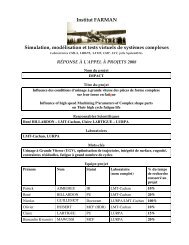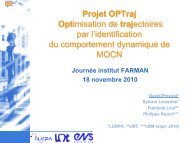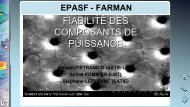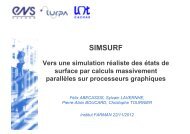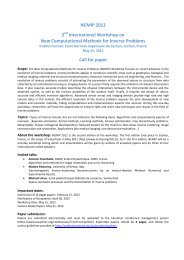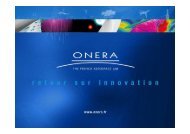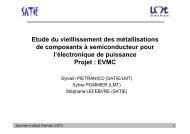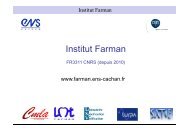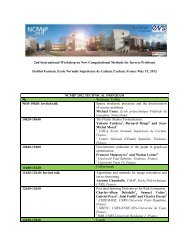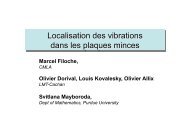DIGISCOPE 2010 Acronyme du projet - Institut Farman - ENS Cachan
DIGISCOPE 2010 Acronyme du projet - Institut Farman - ENS Cachan
DIGISCOPE 2010 Acronyme du projet - Institut Farman - ENS Cachan
Create successful ePaper yourself
Turn your PDF publications into a flip-book with our unique Google optimized e-Paper software.
APPEL A PROJETS EQUIPEX /<br />
CALL FOR PROPOSALS<br />
<strong>2010</strong><br />
<strong>DIGISCOPE</strong><br />
SCIENTIFIC SUBMISSION FORM B<br />
<strong>DIGISCOPE</strong> nodes. It will bring to the project its expertise in pointing and navigation<br />
methods for large displays, participatory design techniques for working with extreme users,<br />
and advanced user interface toolkits such as Metisse for windowing, ZVTM for zoomable<br />
interfaces and Substance for multi-surface interaction.<br />
LIMSI-CNRS<br />
LIMSI is a CNRS laboratory (UPR 3251) associated with Paris-6 and Paris-11 (Paris-Sud0<br />
Universities. The laboratory accommodates approximately 120 permanent personnel<br />
(researchers, professors and assistant professors, engineers, technicians) and about sixty PhD<br />
candidates. It undertakes multidisciplinary research in Mechanical and Chemical<br />
Engineering and in Sciences and Technologies for Information and Communication.<br />
The research activities of LIMSI in Virtual and Augmented Reality (V&AR) is supported by<br />
the VENISE group (http://www.limsi.fr/venise) whose mains topics are: (i) Distributed<br />
architectures and cluster solutions for V&AR systems; (ii) Multimodal interaction in Virtual<br />
Environments, to combine 3D tracking with speech and gesture recognition processes, as<br />
well as to supervise the distribution of information on several modalities conveyed through<br />
Visual, Haptic and 3D audio channels; (iii) Advanced researches on sensory-motor rendering<br />
channels, with Photo realistic visual rendering, Haptic interaction and 3D audio expertises;<br />
(iv) Matching Real and Virtual worlds, to develop new paradigms and algorithms for<br />
Augmented Reality, Augmented Virtuality, and Mixed Reality applications; (v) Paradigms<br />
and metaphors for navigation control and collaborative interactions in Virtual Environments.<br />
VENISE is or has been involved in numerous projects. At the regional level, it leads the<br />
DIGITEO project “SIMCoD” on Collaborative and Multimodal Immersive Virtual<br />
Environments (partners: CEA-LIST and IEF-Univ. Paris-Sud). At the national level, it was a<br />
partner in the RNTL “Perf-RV” platform and the ANR-RNTL “Perf-RV2” project, which led<br />
to a collaboration with PSA Peugeot Citroën. VENISE was the leader of the ANR-ARA<br />
“CoRSAIRe” project (partners: IRCAM, EBGM, Univ. Paris-Descartes and Haption SA) on<br />
immersive and multi-sensory exploration of large scientific data sets (from CFD and<br />
Bioinformatics applications). VENISE is a partner in the ANR-White Program “EVEILS” on<br />
designing Virtual Spaces for Scientific Exploration and E<strong>du</strong>cation. At the international level,<br />
it was the lead partner for several CNRS labs in the European Network of Excellence<br />
INTUITION (vIrtual reality aNd virTUal environments applIcaTIONs for future workspaces)<br />
funded by FP6. Finally, VENISE is a founding member of AFRV and EuroVR, the national<br />
and European associations for the promotion of Virtual and Augmented Reality.<br />
Beyond VENISE, three other LIMSI groups are involved in <strong>DIGISCOPE</strong> for their respective<br />
expertises, namely: (i) the AA group for its research in 3D audio rendering, (ii) the AMI<br />
group for its research in “Virtual Humans”, (iii) the CPU group for its research in<br />
Ergonomics for collaborative tasks.<br />
INRIA-Saclay<br />
INRIA (<strong>Institut</strong> National de Recherche en Informatique et en Automatique, National <strong>Institut</strong>e<br />
for Research in Computer Science and Control) is a French national research institution<br />
focusing on computer science, control theory and applied mathematics. INRIA has 204<br />
research teams distributed across 8 research centers. The two INRIA research teams involved<br />
in <strong>DIGISCOPE</strong> are In Situ and Aviz, from the Saclay - Île de France research center. In Situ is<br />
also a team of Université Paris-Sud and has been presented in the section above.<br />
30/95



